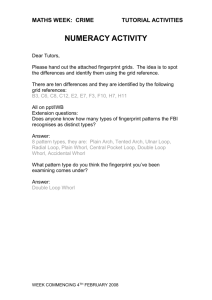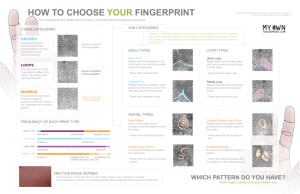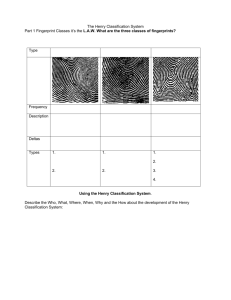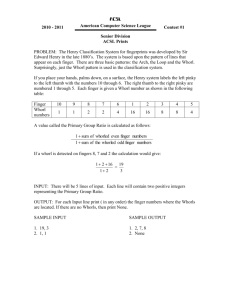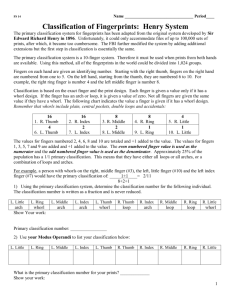Heredity in Fingerprints
advertisement
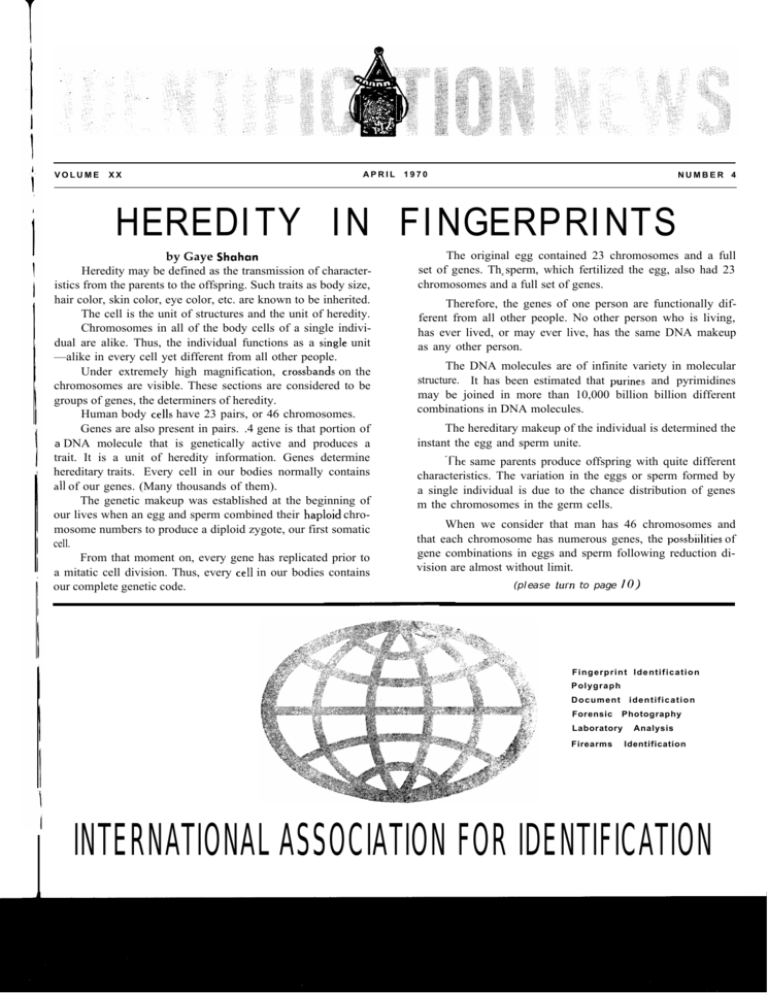
VOLUME
XX
APRIL 1970
NUMBER 4
HEREDITY IN FINGERPRINTS
by Gaye Shahan
Heredity may be defined as the transmission of characteristics from the parents to the offspring. Such traits as body size,
hair color, skin color, eye color, etc. are known to be inherited.
The cell is the unit of structures and the unit of heredity.
Chromosomes in all of the body cells of a single individual are alike. Thus, the individual functions as a single unit
—alike in every cell yet different from all other people.
Under extremely high magnification, crossbands on the
chromosomes are visible. These sections are considered to be
groups of genes, the determiners of heredity.
Human body cells have 23 pairs, or 46 chromosomes.
Genes are also present in pairs. .4 gene is that portion of
a DNA molecule that is genetically active and produces a
trait. It is a unit of heredity information. Genes determine
hereditary traits. Every cell in our bodies normally contains
all of our genes. (Many thousands of them).
The genetic makeup was established at the beginning of
our lives when an egg and sperm combined their haploid chromosome numbers to produce a diploid zygote, our first somatic
cell.
From that moment on, every gene has replicated prior to
a mitatic cell division. Thus, every cell in our bodies contains
our complete genetic code.
The original egg contained 23 chromosomes and a full
set of genes. The sperm, which fertilized the egg, also had 23
chromosomes and a full set of genes.
Therefore, the genes of one person are functionally different from all other people. No other person who is living,
has ever lived, or may ever live, has the same DNA makeup
as any other person.
The DNA molecules are of infinite variety in molecular
structure. It has been estimated that purines and pyrimidines
may be joined in more than 10,000 billion billion different
combinations in DNA molecules.
The hereditary makeup of the individual is determined the
instant the egg and sperm unite.
“rhe same parents produce offspring with quite different
characteristics. The variation in the eggs or sperm formed by
a single individual is due to the chance distribution of genes
m the chromosomes in the germ cells.
When we consider that man has 46 chromosomes and
that each chromosome has numerous genes, the possbiilities of
gene combinations in eggs and sperm following reduction division are almost without limit.
(please turn to page 10)
Fingerprint Identification
Polygraph
Document identification
Forensic
Photography
Laboratory
Firearms
Analysis
Identification
INTERNATIONAL ASSOCIATION FOR IDENTIFICATION
(con!inued
from page 1)
The chance distribution of genes during reduction and
the resulting variation in characters of offspring makes one
person different from another. The particular combination of
genes in one person will never occur again, and has not occurred before.
Genes can be carried without indicating their presence for
several generations, and may then appear at a later time in
some member of the family.
Each gene has a specific function to perform in the development and maintenance of a living organism. There are
regularly two of each kind of gene in each cell. These two
genes are found on two different chromosomes within the cell
and the two chromosomes will always be similar to one another.
The chances of a couple having two children with the
same assortment of chromosomes are so minute as to be considered impossible.
Even though people lived for thousands of years and had
children by the thousands, the possible number of combinations
is still so great that we would not find two children with the
same chromosomes. Calculated by the laws of probability, the
chance that you will have the same assortment of chromosomes
possessed by your brother or sister is one in 281 trillion. This
fails to allow for the exchange of parts o{ chromosomes which
is known to occur. This process would greatly multiply the
before described number of variations.
“The study of human heredity is complicated by the fact
that human beings cannot be mated as are animals; also about
twenty years elapse between generations, and a relatively small
number of offspring are produced.
PATTERNS SUBJECT OF STLTDY
History has recorded that man discovered the appearance
of papillary ridges on the friction skin surfaces of the hands
and feet, and it has been known since the stone ages that these
ridges or corrugations formed patterns of swirls or whorls and
loops especially on the terminal digital joints.
These patterns have been the subject of studies by the
anthropologist, the geneticist and, of course, those who are interested in personal identification through this media. The history of these studies will not be repeated here, but a cry of
alarm has been heard from identification experts when those
m other scientific fields have suggested that their studies indicated hereditary influence on the appearance of the fingerprint
patterns.
lManY researchers on the subject of fingerprint identification have prepared sets of calculations with regard to the percentage of chance involved in duplicating a fingerprint. One
such formula establishes an estimate of the chance occurrence
of each of the fingerprint details separately in the form of a
fraction, such as, one to two. These fractions are then multiplied together to obtain the chance of occurrence. Using only
nine details of identification points, this formula would project
one to the ninth power of fifty or one to one quadrillion, nine
hundred and fifty-three trillion, one hundred twenty-five billion.
10
An early pioneer in these studies, Sir Francis Galton, determined that the chance occurrence was one to sixty-four thousand
millions.
These may be very conservative figures however based on
knowledge gained through research in the field of genetics. No
attempt will be made in this writing to explain any theory or
the laws of genetics, but our text books in the field of human
biology state that the chances of a couple having two children
~vith the same assortment of chromosomes are so minute as to
be considered impossible. Even though people lived for thousands of years and had children by the thousands, the possible
number of combinations, genetic combinations, is so great that
~ve ~vould not find two children with the same chromosomes.
The genes of one eperson who is living, has ever lived, or may
ever live has the same DNA (deoxyrilionucleic acid) make up
as any other person. The DNA molecules are of infinite variety
m molecular structure. It is estimated that the structure (the
joining of purines and pyrimidines) may occur in more than
ten thousand billion billion different combinations in the DNA
molecules.
It would seem, therefore, that the best scientific argument
would be to admit that genetics may play a part in the fingerprint characteristics, if it can be established that this is so,
because the chance probability that any two fingers would be
the same is incomprehensibly remote if we were to assume full
genetic influence.
FAMILY SELECTED
In order to determine the effect, if any, of genetic influence on fingerprint patterns and friction ridge detail, a study
has been conducted of a selected family group.
The particular family was selected for varous considerations. “~he first and an important factor was to obtain a family
with a sizeable number of oil-spring so as to obtain a representative study. A second factor was to choose a husband and
wife pair whose friction ridge patterns contained a number of
like characters. If possible, one would also have been chosen
wherein all ten fingers of each would have been of the same
pattern type. Another factor was to choose a family group with
a number of marriages with issue into a third and fourth generation. With a large family in which a number have married,
lt was contemplated one or more partners brought into the
family group would have patterns similar to those of the family
group. Some will certainly have different types of patterns and
this, it was hoped, would afford an opportunity for comparisons
of the results in children of the third generations. These third
generation offspring would in some cases issue from parents with
pattern types similar to the first generation, and some would be
from parents, one member of whom would be different.
This line of comparison would then continue into the
fourth and eventually succeeding generations.
The family group chosen afforded an opportunity to conduct a number of interesting comparisons. In the first generation
both man and wife have the same pattern types in certain finger
combinations. They both have ulnar loops in the little fingers,
IDENTIFICATION NEWS
five and ten. They both have whorl type patterns in
fingers, numbers four and nine. They have a combinawhorls and ulnar loops in the thumbs, numbers one
and in the middle fingers, numbers three and eight.
I heir index fingers, numbers t~vo and seven, contain a combination of whorl and radial loops.
numbers
the ring
lions of
and six,
—.. .
:r-
ld
on
do
or
an
en
to
usble
It is well known among fingerprint analysts that certain
pattern types appear more often in certain finger positions. The
ulnar loop, for example, may appear more frequently in little
fingers than other type patterns in these digits. Likewise, the
whorl types are observed to appear more frequently in the
thumbs and ring fingers than elsewhere. This is true in the
pattern types in the first generation couple in this study. Also
of interest is the fact that the ring and little fingers contain the
same type of patterns. ‘rhe thumbs are different but are alike
as to each partner. There are differences in index and middle
fingers but of interest in these digits is the appearance of the
radial loops, two in the husband and one in the wife.
hat
~es.
lay
up
ety
the
Ian
4A
lent
~erSo,
be
full
inudy
leramily
:preand
:r of
losen
same
with
genried,
~ the
imily
i and
‘isons
third
with
ld be
o the
j conration
finger
ngers,
NEWS
I
1
I
I
>
To follow this study experiment, the following system
was adopted: The initial husband and wife group are considered as the first generation. Following generations are then numbered consecutively. In the second generation there are a total
of thirteen members, and whether or not their fingerprints became
a part of this study, they are numbered one through thirteen
according to birthdate. Members of subsequent generations are
also assigned numbers according to the generation number and
order of date of birth. The numbering system will retain the
second generation and all following generation number designations. For example, the first born of the elder child of number
one in the second generation will be assigned one-one-one. Each
nurceral indicating the first born from each generation from
second through fourth.
Illustrations will designate finger locations by numbers
one through ten. The right thumbs will be number one and
right little finger number five. The left thumb will be number
six and the left little finger number ten.
The fingerprint pattern types used herein are the plain
arch, tented arch, radial loop, ulnar loop, and whorl. The
types will be designated as A, T, R, U, and W.
For the purpose of the general survey and study, all
whorl types are grouped into one. All questionable patterns
are grouped under the preferred pattern type. The grouping of
questionable patterns became a difficult task. Although it was
not done in this experiment, it is believed that when this type
of survey is being conducted, the strict rules governing fingerprint pattern type designation should be relaxed.
As fingerprint technicians have observed, the loop type
patterns with a number of converging ridges opposite the looping
ends of the ridges frequently have the casual appearance of
whorl types. There are also the tented arch types of patterns
which on casual examination bear the general appearance of
the 100PS.
IDENTIFICATION NEWS
Some of the initial observations made are depicted in the
following charts or examples:
Example number A shows the pattern types in the first
generation:
Exarrple number B is the pattern types of available members of the second generation.
It is interesting to note here that the ulnar loops in fingers
number five and ten, the little fingers, continued through the
second generation. The whorl type in numbers four and nine,
the ring fingers, continued through all of the second generation
except number nine finger in the thirteenth member. This pattern
is a loop ~vith converging ridges previously mentioned.
Some additional observations are noted. The W. P. combination in numbers one and six continued ~vith variations except in number two. The radial loop in this case is of a type
~vith ridges simulating the whorl type.
The radial loop in numbers t}vo and seven fingers failed
to carry through although the majority did have radial loops
in the right hand digits and a representative number in the left.
Digits three and eight, the middle fingers, ~vere three W.
and one U. in the first generation. The U’. in the right middle
finger of the father appeared to dominate, however, the U.
appears also in the left hand digits of the second generation
~vhereas both parents have W. in these digits.
Additional observations of interest may be seen in third
and fourth generations.
FIRST GENERATION
Husband
Wife
F I N G E R NLTMBER
6 7 8 9 1
1 2 3 4 5
WRUWUWRWW
URWWUUW’TVW
EXAMPLE — A
0
LU
SECOND GENERAI-ION
i.
2.
4.
5.
6.
7.
9.
il.
{3.
WRWWUWWWW
U
Son
Son
RAUWURTUWLDaughter WRWWLTUUWW LDaughter LIUUl&’~URWW CSon
WRUWL’WWWW U
Son
V’RUWUU-RUW
U
WULIWUUURW
U
Son
UT AWUWRUVVC
Son
Son
WRUWUWRUTUT C
In example 1. the spouse brings additional ulnar loop
type patterns into being. The percentage is seven and three, U.
to W., out of ten. The W. and U. in ring and little fingers,
however, remained constant. In the two offspring only I -2
carried the W. in four and nine, whereas I -2 picked up the
U. in these two digits. The U. in five and ten remained constant in this third generation group.
(please turn poge)
11
1 ‘he one married member here, 1-1, added additional
U. patterns, seven out of ten. The spouse in this mating is
the first example of a W. in a little finger, number five. It is
very interesting to note that a whorl also appears in number
five in one of the two members, 1-1-1, of this fourth generation.
Also of interest is the appearance of radial loops in ring
fingers, four and nine of 1-1-1, and four of 1-1-2. This pattern
had not previously been seen in these digits and if we are to
attribute its appearance to heredity it may be assumed that it
originated in the father’s background. The radial loops in the
index fingers here is consistent with percentages up to this point.
THIRD GENERATION
Example 1
W R W W U W W W
Husband
Wife
W
Uwuwuuuuw
U
u
THIRD GENERATION
W A UUUWRUUU
Daughter 1-1
Wwwwuwwwwu
Daughter 1-2
THIRD GENERATION
Example 1-1
Uuuuwuwuw
Husband
Wife 1-1
W
A
u
UUUWRUUU
FOURTH GENERATION
W R U R W U R U R U
Daughter 1-1-1
URURUWUUUU
Daughter 1-1-2
As we examine example 2. of the third generation, it is
observed that the spouse has only loop types, U. in all except
index fingers and R. in those digits. The firstborn of four in
this group, 2-1, brings only ulnar loops except one, the T. in
number two. Number 2-3 also has loops except the W. in
number six and the T. in number seven. The W. in six is
a double loop type whorl and is the first appearance of this
type. The T. in number seven has the casual appearance
of an R.
Additional members of this third generation, numbers
2-2 and 2-4, continue whorls in ring and ulnar loops in little
fingers except number nine of 2-4 which is the coverging ridge
type of loop with the casual appearance of the whorl.
The spouse of the married member, 2-1, of this third
generation group returns whorls in the ring fingers.
Husband 2
Wife
THIRD
Son 2-1
Son 2-2
Son 2-3
Son 2-4
THIRD GENERATION
Example 2
R A U W U R T U W U
URUUUURUUU
GENERATION
UUUUUUUU
U T
Wuuwuwuuw
u
UUUUUWTUUU
WTUWUWTUUU
“rHIRD G E N E R A T I O N
Example 4
Husband
Wife 4
Uuuuuuuuuu
W
R
W
W
U
U
U
W
U
THIRD GENERATION
UUTUUUUUUU
Daughter 4- I
UURUUUURUU
Son 4-2
WUUWUULTWW u
Son 4-3
Example 5
UUUWUURWW
U
Wife 5
H u s b a n d
W W U W U W W
W W W
THIRD GENERATION
U R W W U U W U W U
Son 5-1
D a u g h t e r
5 - 2
W U U U U U
U U U U
Daughter 5-3 Uwuwuwwuww
FOURTH GENERATION
Example 2-1
UUUUUUUU
Husband 2-1
U T
Uwuwuuwuw u
Wife
FOURTH GENERATION
Son 2-1-1
Wuuuuuuuu u
WA L~UUWUAUU
Son 2-1-2
h example 4 of the third generation, the spouse is the
first example of a group member with ten ulnar loops. The
second generation member, number 4, of this couple has whorls
in digits one, three, four, eight, and nine. The effect of the
additional ulnar loops by the father of the offspring here is
interesting. There are no whorl type patters in 4-1 and 4-2.
4-3 repeated the whorl of the mother and in the same digits.
It did not repeat the R of the mother in number two finger.
Example 5-1
Husband 5-l U R V’ W U U W U W U
URUUUUUUUU
Wife
Second generation members six and seven are twins, believed to be identical twins. The two spouse are sisters. In both
examples the spouse have only U and T types.
In example 6 the second generation member’s patterns
are made up of six W types including the constant W in ring
fingers. The U constant also appears in the little fingers.
This example is interesting because the W type does not
appear in one digit of any of the five third generation offspring.
Radial loops in index fingers may have been carried forward
but the only constant is the U in little fingers and it may be
reasoned that the ulnar loop is most frequently found in these
digits.
The number seven second generation member has the
same pattern types and in the same order as its twin in the
right hand but bears a striking difference in the left hand.
The two off-spring here do not continue the W types
and only one, 7-2. has whorls in right thumb and ring fingers.
IDENTIFICATION NEWS
Here it may be observed that the pattern types of t~~ins
may be different and, although the two wives are sisters, no
substantial influence is noted unless it is a tendency tovvard
influence of a predominance by the ulnar loop types.
.I1
I
:.I
1
1
I
1
1
I
r
J
J
J
J
e
e
s
e
s
,.
i.
.
-,
I
I
1
i
I
I
!
J
J
:h
1s
[g
3t
Ya“
d
]e
se
Ie
l.e
es
“s.
s
!
I
I
[
[
I
I
I
I
I
‘rHIRD GENERATION
Example 6
H u s b a n d 6WRUWUW WWV’ LUUUTUULTUU LWife
l_JRUUUURRI_T L“
Daughter 6- I
UT UT UURUU L“
Son 6-2
Son 6-3
UUTLTUUTUU LLDaughter 6-4
LTUUUL’UURU
Son 6-4
UUUUULJLJCLJ L“1 H I R D G e n e r a t i o n
Example 7
U
WRUWUURUW
Husband 7
U-r LJUUUTUU L“
Wife
‘rHIRD G E N E R A T I O N
u
UTUUUURUV
Son 7- I
Daughter 7-2 W RUV’UUUCU u
Early studies established that the occurance frequency of
certain pattern types is greater than others. Researchers have not
been in complete agreement but the variance between their findings has been slight. An average of the research results has
established about 65 percent of all patterns are ulnar 1 00 PS .
About 30 percent are whorls and about 5 percent arches.
A study conducted by Scotland Yard consisted of the
examination of the pattern of 5,000 individuals and percentages
of pattern appearance established for the 50.000 fingers. The
results, less amputated or other~vise missing or scarred fingers
is depicted in example D.
It is noted here that the percentages are: A, 4 percent;
T, I percent or a total of 5 percent for arches. The loops ~vere
6 percent for radial and 64 percent for ulnar, or 70 percent for
all loops. The total for all whorl types was 25 percent.
When this type of comparison is applied to the group
being studied in this experiment there appears to be an influential trend toward the predominance of ulnar 1 00P type patterns.
The original couple presented fifty percent whorls, thirtYfive percent ulnar loops and fifteen percent radial loops, or fifty
percent whorls to fifty percent loops and no arches.
The second generation members reduced the whorl percentage [o thirty-nine. The 100 P percentage increased to fiftYseven and four percent arches including tented arches ~vas
added.
The second generation was then combined with marriage
partners, and this reduced the whorl percentages to thirty-one.
The 100P percentage increased to sixty-four, and arches increased to four percent.
It is noted at this point that the percentages have closely
approached the established average levels. This may, in part,
be the influence of 100P type patterns added to the study group
by marriage partners.
IDENTIFICATION NEWS
EXAMPLE D
Pattern
Arch
T. Arch
R. Loop
U. Loop
Whorl
Pattern
Arch
T. Arch
R. Loop
U. Loop
Whorl
FIRST GENERATION
1 2 3 4 5 6 7 8 9 1 0
T o t .
. . . . . . . . . .
. . . . . . . . . .
1
2
.
ii
i.i
1 I
1.12.
EXAMPLE D-1
.
.
22
(~
0 0
0 0
. 3 .150
2 7 .350
. 10 .500
SECOND GENERATION
1 2 3 4 5 6 7 8 9 1 0
T o t . ‘i
0 1 1 0 0 0 0 0 0 0 2
. 0 2 2
0 1 0 0 0 0 1 0 0 0 2
. 0 2 2
1 5 0 0 0 1 4 1 0 0 1 2
. 1 3 3
2 2 6 0 9 4 2 4 1 9 3 9
. 4 3 3
6 0 2 9 0 4 2 4 8 0 3 5
. 3 8 8
EXAMPLE D-2
SECOND GENERATION AND SPOUSE
1 2 3 4 5 6 7 8 9 1 0
T o t . (i
Pattern
1 .008
Arch
.
1
.
.
.
.
.
.
.
4
.033
1
. . 2 . .
T. Arch . I . .
.
. . 1 0 . 0 8 3
R . L O OP 1 5 . . . 1 3
6 3 1 0 3 1 2 8 4 7 4 1 1 6 8
. 5 6 7
U. Loop
5 2 2 8 0 3 3 5 8 1 3 7
. 3 0 8
Whorl
Twenty members of the third generation, as reflected in
chart D-4, possess patterns in approximate proportion to the
established standard. The w-horl percentage has dropped about
five percent under the standard and the loop percentage about
five percent over. They may be accounted for by an indication
of a tendency of the radical loops to carry through. The percentage of radial loops is slightly higher than a standard expectation.
Chart D-4 combines the third generation and their marriage partners. The percentage of appearance of pattern types
has remained very comparable to the standard.
Members of the fourth generation have not been completely examined, but those available for comparison reflect
fifteen percent whorls, fifty-eight percent ulnar loops, and thirty
percent radial loops. This is an extra-ordinary large radcial
loop percentage and one half of these appear in ring fingers.
This pattern has not previously appeared in those digits.
It will be necessary to explore the paternal family line of
this fourth generation to determine the possibility of a genetic
origin of these developments.
Another very interesting development is noted in third generation example 5. The spouse in this case returned whorls to
the group, eight of ten fingers. This includes the W in the little
finger, number 10, which is noted in the same digit of 5-3.
(please furn page)
13
THIRD GENERATION
Pattern
.~rch
T. Arch
R. Loop
G. Loop
Whorl
1
2
1
3
4
5
6
7
.
8
.
9
1
0
.
.
Tot. f4
I .005
.
.050
14 .070
6 3
41
3“ 9 14 11”20” 14” 8 14 15” 19” 37 .685
. 2 1 . .10
.33i:
7 3 2 8 0 6 4 2 5 1 3 8 . 1 9 0
EXAMPLE D-4
THIRD G E N E R A T I O N A N D S P O U S E
Pattern
.Arch
1 2 3 4 5 6 7 8 9 1 0
.
T.
Arch
R.
Loop
1
.
.
.
1
.
LT. L o op
3
Whorl
1
.
.
1
.
.
4
1
.
3
.
.
.
.
Gaye Shahan is a p r o f e s s o r at Aliami-Dade ]unior College,
.14iami, Florida.
.
.
.
T o t .
.
.
.
.
I
.
.
.
.
%
.
1 .025
.
I .025
.
1 .025
3
3
1
4
2
4
2
8
.
7
0
0
1
1
1
2
.
2
.
9
.
2
2
5
EXAMPLE D-5
SUMMARY
DRIFT TO ULNAR L O O P
R
A
T
Pattern Type
.006
.06
}’ard Survey
.04
.00
.15
1st Generation
.00
.02
.13
2nd Generation
.02
.08
2nd and Spouse
.01
.03
3rd Generation
.01
.05
.07
3rd and Spouse
.03
.03
.03
-ith Generation
.05
.00
.15
Uw
.64
.35
.43
.56
.69
.70
.65
.25
.50
.39
.32
.19
.23
.15
Fingerprints are not alike or different because they are of
the same or different pattern types. Identity is established or
denied by the minutia of smaller detail. The ending ridges, bifurcations, or forking of ridges, the islands or enclosures, the
short ridges and dots that make up the patterns, and the surrounding friction skin area determine whether or not fingerprint
~i’as made by the same finger. It is not only the appearance of
these details in the fingerprint, but their relative position to each
other is also a major factor in the identification procedural process.
In this study experiment each digit from the first through
the fourth generation was examined to discover instances in
which these minutia may have been repeated. There were no
similarities between any t~vo fingers or any one member of this
group or between any finger of one member to a finger of
another member.
The close examination of this minute detail disclosed that
the fingerprints may as well have been taken from persons at
~andom so far as any detail likeness is concerned.
In summary, those points of most interest were the carrying through or whorl type patterns in the ring fingers seemed to
be influenced by the first generation couple. This could also be
said of the ulnar loop in the little fingers.
These studies of friction ridge finger-tip pattern type has
provided an abundance of detail indicating that the laws of
heredity and genetics may control these human body characteristics just as surely as it has been proven that they control other
characteristics. There is also to be found unlikenesses and dissimilarities which can be used to argue that genetic influence is
not present in this area. These instances of failure to correspond
with the study family pattern type appearance may well be
explained by recessive genes in the study group or may have
The most interesting development was the appearance of
the whorl in the left little finger of the husband of member number five of the second generation and the re-appearance of a
}\.horl in this digit in 5-3.
been influenced by the marriage partners’ families.
Another very interesting and possibly a very significant
development was the trend toward the established basic percentage of pattern types in this study group. There may be a
formula factor which can be applied to this tendency if additional studies establish that there is such a drift pattern.
The most important quesiton, however, is whether or not
the details of fingerprints upon which identification are based,
may be influenced by genetics.
Pattern
Arch
T. Arch
R. Loop
U. Loo p
Whorl
14
1
122
1
11
2786
~_J65
2
425
114
1291
1602
1537
3
273
30
126
3719
823
This occurred again in the right little finger of the husband of 1-1 in the third generation and re-appeared in the same
digit of 1-1-1 of the fourth generation.
PATTERN DRIFT TO LOOP
SCOTLAND )-ARD SURVEY
4
6
5
7
~’25
91
27
418
97
1
0
0
10
73
10
1161
2769
4254
3287
1893
2045
687
1466
1399
8
354
43
125
3647
805
9
133
4
25
3429
1384
10
57
1
1
4466
449
Tot.
2125
291
2833
31852
12660
~
.042
.006
.056
.637
.253
IDENTIFICATION NEWS
IDENTIFICATION NEWS
MAY 1975
If any reader knows of similar “whole hand mirroring”
within a family involving five or more persons, I would
appreciate hearing about it.
*
u w
u w
NANCY
w w
w w
w
w*
I
Conclusion:
We arrived at several conclusions as a result of our
family fingerprint project. For one thing, we found out
in a hurry that attempting to take the prints of youngsters under two years of age can be likened only to
trying to bait two hooks at once with a couple of
hyper-active worms. Any legislator, state or federal,
who ever introduces a bill requiring that all 10 prints
of newborn babies must be taken immediately after
birth should definitely be recommended for psychiatric treatment!
I
I
1
I
I
w
Another conclusion that we agreed upon was that
family fingerprinting can be fun. There is a real challenge in it for the fingerprint technician, whether it is
in looking for unusual prints, similarities within the
family, or pattern distribution that might just possibly
give some hints regarding inherited trends. There are
also some pitfalls. Inked fingers can cause unbelievable problems when they are attached to wiggly grandchildren.
&
I sincerely hope that this article, which does not
pretend to be a scientific research endeavor, will
prompt many other I. A. 1. members to start a fami[y
fingerprint chart. The results could be interesting, and
I’m sure that Chairman William Freele of our Subcommittee on Fingerprints would be anxious to hear about
any unusual charts that were compiled. A collection
of such charts just might prove to be a most interesting
exhibit at a future 1. A. 1. meeting.
I
I
I
u w
u w
.
u u
u u
JOSEEH
w
w
4
I
I
I
I
1
t
w
w
GREGORY
w w w
w w w
w
w
I
,
Rather than sign my name at the end of this article,
I have included the print of my left index finger. If
you look real carefully at Figure 6, you just might
find my middle initial at the core.
I
I
I
1
*
t
w
JANET
P A G E
w
a
I
u
w
w
1
w
FIGURE 5.
w u w
w
FIGURE 6.
11
